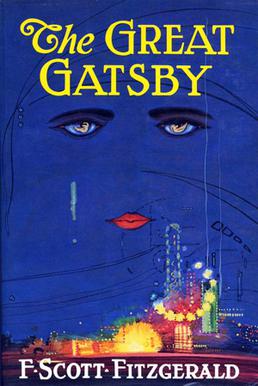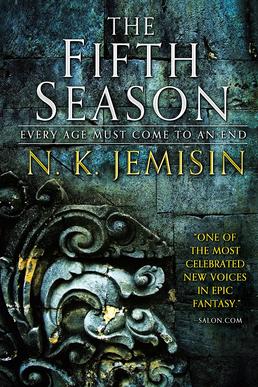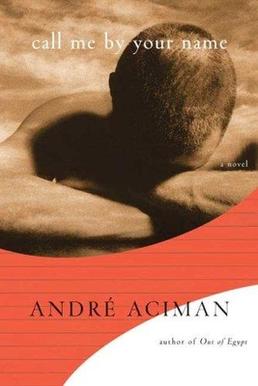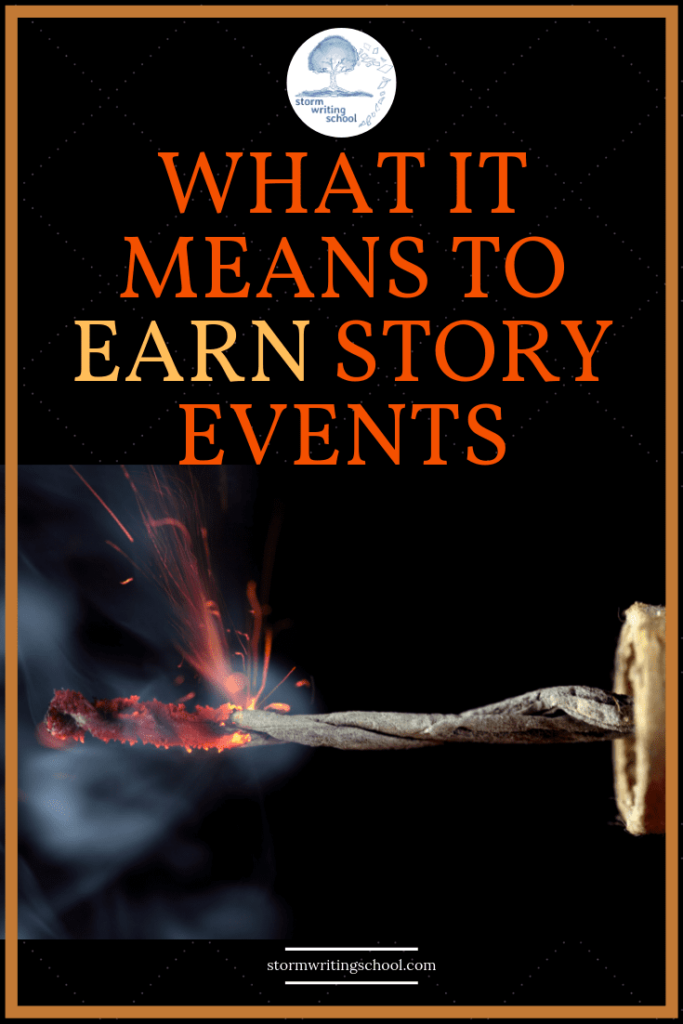Story events are propelled by character reaction
I’m using the term “story events” here rather than “plot developments.” Why?
Plot is, as Lisa Cron says, “What happens in the story; the surface events.” But story is about “how the things that happen affect someone.”
Jennie Nash adds that readers read for “the why not the what.”
Chuck Wendig says that characters create plot through their decisions: “Characters have needs and wants. Even better, they have problems, and perceived solutions to those problems. And they are driven to pursue those solutions, to fulfill needs and desires, to overcome or run from fears and limitations. In this pursuit, characters create plot.”
So, I opt for the phrase “story events” because unlike “plot developments,” it forces us to acknowledge that things happen because of character reaction.
(See my previous post on cause/effect for some more discussion on character reaction as a driving mechanism of story.)
Earning (what it is)
This brings us to the concept of earning story events. Stories can certainly have some unearned plot developments—usually in the form of disturbances/trouble—which can occur at any point but often congregate around the beginnings of scenes. However, a story is really propelled by character reactions.
And a big part of being a storyteller comes from your ability to make those reactions feel plausible or earned.
When readers understand how a character’s reaction arises out of a context, that reaction will be natural and logical and consistent. Let me clarify: the reaction itself doesn’t have to be logical, but it needs to come about logically. It can be an irrational reaction; it can be surprising. But we should be able to recognize, in retrospect at the very least, where it’s coming from.
Three types of context
You can get almost any character to react in almost any way as long as you finesse the contexts around their reaction. I like to break context down into three types.
Deep context
Deep context is about character history and personality. What kind of person is this character? What do they believe in? What flaws do they have? What’s their backstory? What’s their deepest need?
Deep context—which is the most icebergy of all the contexts (meaning most of it should remain off the page and below the surface)—manifests in a character’s attitude.
Examples of deep context

Take Jay Gatsby from The Great Gatsby. His deep context is that he was a poor Midwestern kid who fell for a wealthy Kentucky girl and, insecure about his lower class background, decided to make a fortune by whatever means necessary to be “worthy” of said girl. He cultivated a fake high-class persona and otherwise had a single-minded ambition of winning the love of that out-of-his-league woman. His attitude is thus a combination of deep insecurity and surface-level confidence.

Essun in N.K. Jemisin’s The Fifth Season is an orogene, someone who can channel the energy of the earth for various magical effects. However, she’s kept this hidden in her small village for the past 10 years, supressing her gift/curse lest others’ fear of her drive them to bring harm to her or her children. We know she’s trained/educated and quite capable. But we also know that she chose a life of quiet anonymity.

Elio in Call Me by Your Name is a smart, cosmopolitan, multi-lingual child of an academic who is sexually inexperienced, especially with regards to his homosexual impulses. He’s a naive intellectual.
Situational context
Situational context is about the character’s state of mind in this particular situation. When you put your character into a scene, what do they want in that specific scene? What other distractions do they face? What conflicts are they up against? What impression do they want to make on others around them?
Situational context is all about state of mind, usually arising from the scenes immediately before the current scene. The character’s desire and/or the conflict they’re facing causes this state of mind and colors most of their reactions.
Examples of situational context
When Gatsby meets with Daisy in Nick’s house, the situational context is that he’s about to reunite with the girl of his dreams. He’s thus insecure and nervous coming into the encounter.
When Essun is at the gate of her village, about to be allowed out after the surrounding territories have suffered damage from an earthquake, the situational context is that she found son dead two days prior, murdered by his father. She’s coming from days of listless mourning, trying not to think about what has happened to her son. And the only thing keeping her from giving over to grief entirely is her desire to find her husband and her daughter, who may be alive. However, people in town are starting to suspect her of being an orogene and thus mistrust her. On her way to the gate, she can sense the simmering tension of their disapproval. But she wants only to leave and never come back.
When Oliver gives Elio a friendly “hug-massage” one day, Elio has already considered his attraction to Oliver. In fact, the night before, he had a dream about Oliver appearing in his bedroom and then lying on top of him. And in that dream, this thought occurred to him: “This is like coming home, like coming home after years away among Trojans and Lestrygonians, like coming home to a place where everyone is like you, where people know, they just know—coming home as when everything falls into place and you suddenly realize that for seventeen years all you’d been doing was fiddling with the wrong combination.” That’s our situational context for the next day’s touch from Oliver.
Immediate context
Immediate context is about the stimulus that immediately precedes a reaction. Usually, the reaction is triggered by some external stimulus. Dwight Swain speaks of M-R Units—Motivating stimulus, Response Units—that animate the beats within a scene. Somebody says something; the protagonist replies. A horse whinnies in the pasture; the protagonist looks out the window. A rain drop falls; the protagonist runs for the porch.
Swain points out the response often begins with feeling, then moves to thought, then moves to dialogue or action. It’s not that you have to depict feeling, thought, and action within any given reaction, but that’s the typical order in which humans react to stimuli. Which is to say that the reaction you show on the page can be purely internal, purely external, or a combination of both.
Examples of immediate context
After Gatsby and Daisy have met in Nick’s living room, Nick excuses himself to give them a chance to talk privately. But Gatsby suddenly doesn’t want to be left alone. Nick narrates, “He followed me wildly into the kitchen, closed the door, and whispered ‘Oh, God!’ in a miserable way.”
When a woman fires a crossbow at her, Essun reacts by doing what she can do with the earth and the air, rendered here in second person: “Because you don’t think, because you’ve been trying not to think and this means you’re out of the habit, because thinking means you will remember that your family is dead and everything that meant happiness is now a lie and thinking of that will make you break and start screaming and screaming and screaming, you reach for the air around you and pull and brace your feet against the earth beneath you and anchor and narrow and when the woman fires the crossbow, the bolt blurs toward you. Just before the bolt hits, it bursts into a million glittering, frozen flecks.”
Elio’s reaction to Oliver’s hug-massage is to flinch: “I was so spellbound that I wrenched myself free from his touch, because a moment longer and I would have slackened like one of those tiny wooden toys whose gimp-legged body collapses as soon as the mainsprings are touched.”
Combine the contexts
An earned reaction arises when all three contexts coalesces to make a reaction feel authentic. A wealthy Midwesterner-turned-new-money-East-Coaster (deep context) finally faces the girl he’s obessessed over (situational context) and is left alone to talk with her (immediate context). A trained orogene-turned-small-town-wife (deep context), grieving the death of her son and recently learning of his murderer’s whereabouts (situational context), is fired upon by a villager fearing her magical abilities (immediate context). A naive intellectual teen (deep context) dreams of a sexual tryst with a grad student (situational context) and the next day is touched by his crush (immediate context).
Build over time
But there’s a very important final ingredient to earned reactions. They often require a build over time. Even if you have your contexts right, you might end up rushing a scene and thereby not allowing readers to fully understand how a character has arrived at an emotional state or an action.
It’s the seemingly uncharacteristic stuff you have to be most careful with. Shifts in emotion, surprising decisions, even crimes of passion—these can catch us off guard, but should make sense in retrospect.
Put it this way. Fireworks have fuses. Allow us to watch that fuse burn down before the explosion. We don’t need to know in advance what the nature of the explosion will be (a loud bang, smoke bomb, a frenzy of spinning sparks), but we should know that the pressure is mounting.
Examples of building over time
Essun’s magical outburst needs some weight behind it to build the proper momentum; to have her do her magic immediately after finding her dead son could have made sense, given her various contexts, but it would have come with a lot less dramatic tension and it would not have been quite as tragic as—well, I won’t spoil it.
Jemisin allows Essun’s reaction to build over time. We see Essun wallow in grief for days, learn that her daughter was last seen alive with her husband, and walk through the heart of the village to feel the mistrust of those around her before she gets to the scene in which she uses her powers. And what’s more, she’s completely irrational during her outburst. She blames everyone in the city for the death of her son. To truly earn that surprising shift, Jemisin needed time.
Had Elio read Oliver’s backrub as flirting, it may have been a believable reaction, but it wouldn’t be fully earned because it arrives without any build. Andre Aciman allows ample time for us to watch Elio overthink and second guess time and time again before there’s any understanding of flirting going on.
Foreshadowing isn’t earning
There’s a certain very popular TV show that is in its final season right now and is very much rushing its twists and turns. As Sarah Marrs points out in an essay about the show, “Foreshadowing is not the same thing as raising tension.” Some apologists for this particular show like to point to earlier seasons as evidence that the current revelations are “earned.” But they’re not earned simply by being foreshadowed. Foreshadowing sometimes comes in the form of hints or setup; sometimes it comes in the form of establishing deep context. But foreshadowing never provides situational or immediate context and thus can never solely account for earning a story event or character decision.
The bottom line: if you rush your scenes or your story, character reactions will feel unearned even if we can intellectualize how the contexts are right for said reaction. A reader wants to co-experience story events with the characters. Allow readers to watch the fuse burn. Give some time for the build.
(I’ve previously written on how to build toward character realizations and epiphanies, which also requires some movement over time.)
Workshop your earning
So what can you do with this information? Well, you can use it to be systematic about finding the source of your problems if a reader tells you some part of your story feels unearned.
- Does the story event feel unearned because of inadequate context or because it was rushed?
- If it’s a matter of being rushed, then stretch the scene; give it more tension; give it a few more beats so we can trace some responses and emotional shifts.
- If it’s a problem of context, figure out which one.
- Does the reaction feel inconsistent with the character?
- Does it seem not to have enough scene-level development behind it?
- Or is it a matter of the smaller beats within the scenes feeling forced?
- In other words, what seems off: the character’s personality, their state of mind, or their immediate reaction?
And by the way, my Story Momentum Mastery course has a unit on crafting setup and payoff that is guaranteed to help anyone looking to tighten up their stories.


This article is part of the Author Toolbox Blog Hop. To continue hopping through other great blogs in the monthly hop or to join, click here and/or search #AuthorToolboxBlogHop on Twitter and Pinterest (here’s the group board).








17 Responses
I just saw this. Thanks, Tim.
Yea: the comments are working! *high fives air* I have a few of your posts bookmarked so I can refer to them for a refresher while I’m writing and editing, and this one’s about to join the list!
Thanks, Raimey! I hope your writing is going well.
Great post with tons of information. Could you send a copy to the Game of Throne writers. Talk about rushed ….
Haha! No kidding! It’s maddening on so many levels.
The idea of various context seems key. I written intuitively and then in the revision looked upon a smattering of reactions and pushed into place emotions wondering why my fiddle sounds out of tune. After considering your well considered points, I see a time when a little witholding could do wonders in the tension and driving events, or story. I’m working through a small bit at the moment and resisting with every fibre the notion of foreshadowing, backstories, and expo when all I need to do is properly place the context. I can show two, and leave the third to emerge later, or I can order all three for a more cinematic effect, or I can work with just one –which is a bad idea, and leave the reader guessing.
Yes! A little withholding can certainly go a long way.
Thanks for articulating this so clearly. I know I sometimes want my characters to act in apparently uncharacteristic ways. Although *I* know what drives them to do so, allowing the reader to appreciate it (without belabouring the setup/evidence) is a real challenge.
Thanks! Yes, it is definitely a challenge. Jennie Nash refers to this challenge as the “writer’s burden of knowledge.” We need to get what’s in our head onto a page so it can get into a reader’s head.
This is like adding a power tool to my screw drivers and hammers.
A very insightful analysis, though I wonder if there’s another variable in the mix, whether audiences have seen the context first hand, or heard about it second hand?
If a context is entirely rooted in one or more prior scenes within the story, that’s a far cry from a memory or summarized account that may leave audiences wondering if they have the whole story.
Interesting! I’m not sure I fully follow what you’re getting at (I might need to see examples to study it), but I think I understand your point that a summarized or second-hand account may not be adequate context for an event?
Oh, this is ridiculously helpful!! As someone who writes almost entirely “character-driven” work, I always find the most popular advice on how to build towards significant moments inapplicable to what I’m struggling with. Even when I find articles geared towards romance novels (which I assume to be very character-driven), they seem to assume that romances are mostly just as “plot-driven” as genre fiction — i.e., that the climax of the novel will come from the protagonist solving an external problem that seems to exist independent of the character motivations, in order for the two lovers to come together.
Also, coming from the perspective of an actor — the three contexts make complete sense. In acting classes, you’re taught massive amounts of theory, mostly relating to analyzing the deep context of a character in a scene. Of course you’re probably not thinking of a made-up memory about your character’s fifth birthday party or whatever when you’re on-stage and in an argument with your “mother”, but the point of all that tablework is to figure out the context for yourself, so that you have a foundation that’s rooted in the text and will ultimately make your character more complex and realistic, even when you’re mostly told to forget about it in favor of being present in the scene.
I’ve found it very easy to apply certain elements of acting theory to writing (character objective, goals, and tactics, dialogue beats, conflict, and etc.) but this is the first time I’ve made a connection between that type of tablework and how it can be utilized in writing, so thank you so so much for this article and for helping me make that connection!! (Although whether I’ll actually be able to execute the theory I now understand is another thing entirely…haha.)
Thanks so much, Grace, for your kind words and for sharing the actor’s perspective. Definitely a lot of overlap between that practice and this concept. I’m so glad this explanation resonated with you!